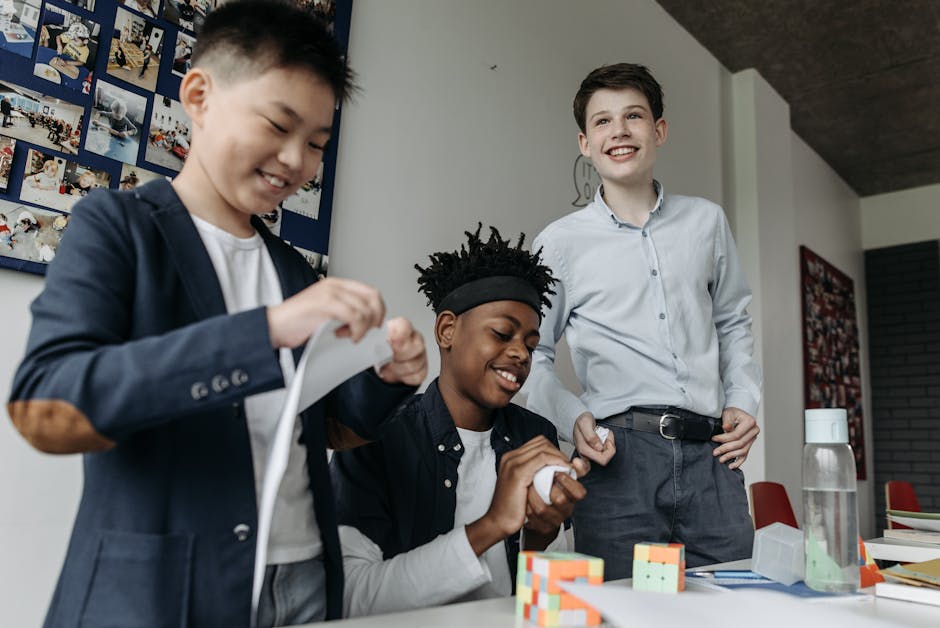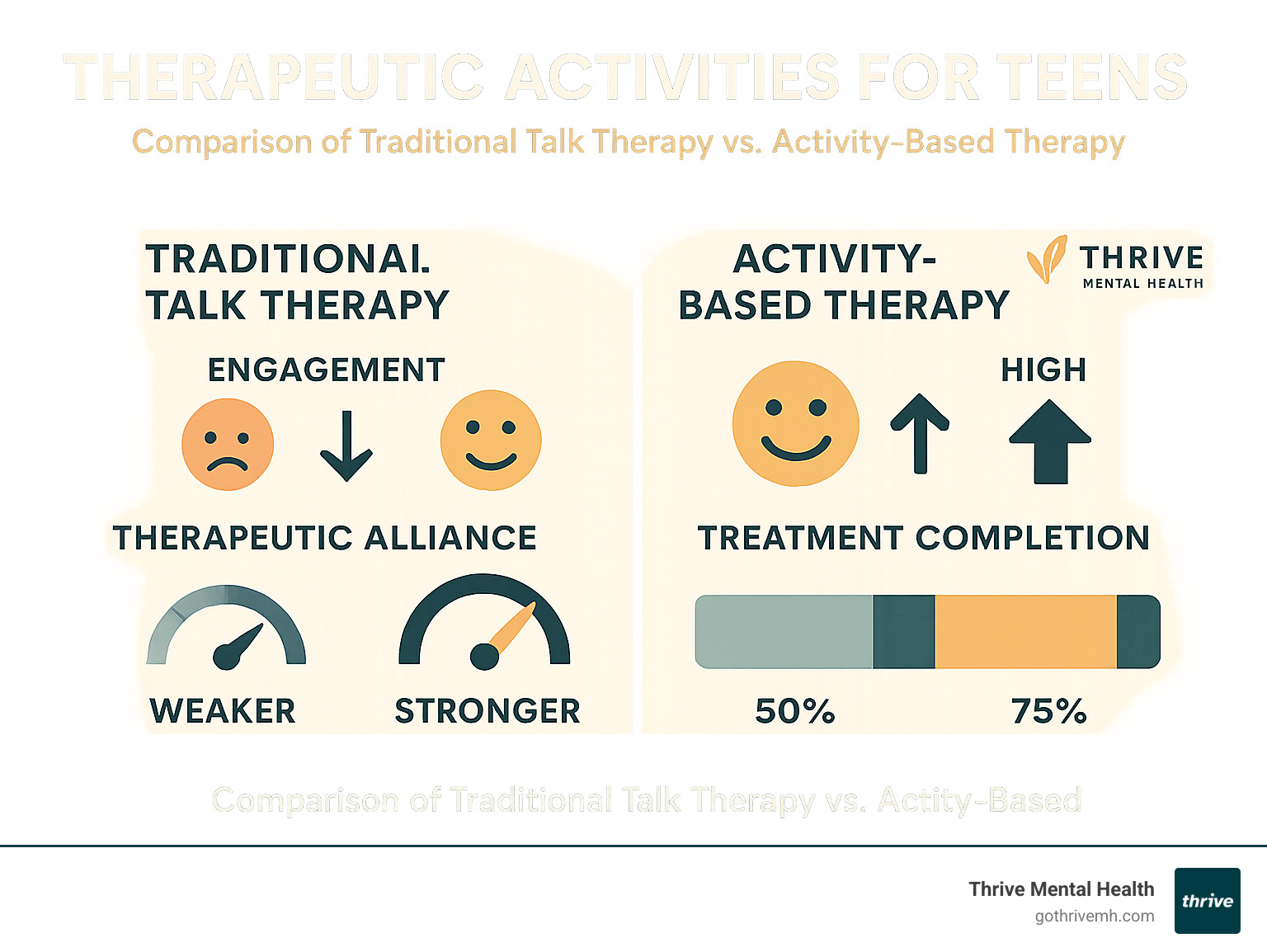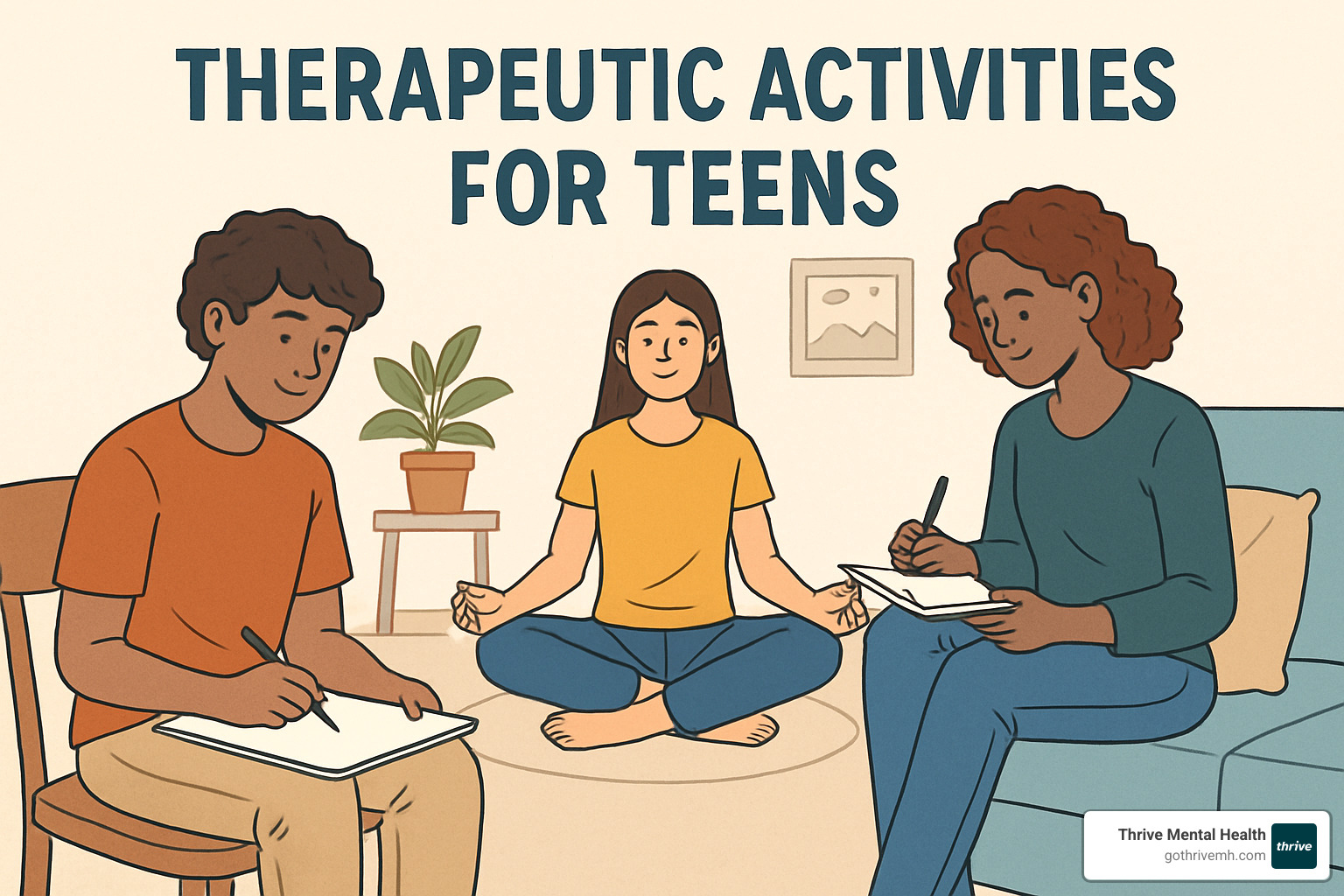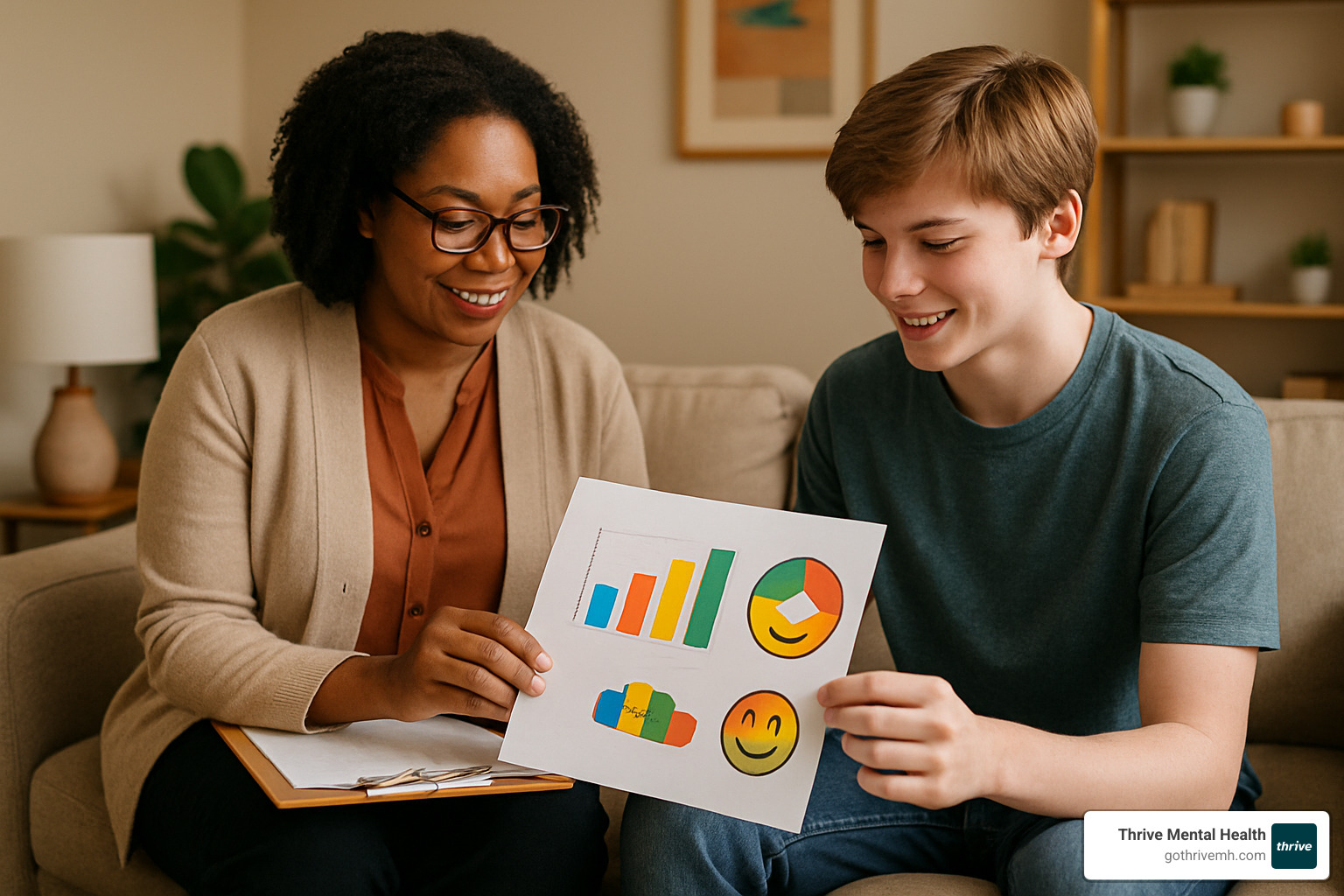10 Therapeutic Activities for Teens Who Think Therapy is Boring

Why Creative Engagement Matters in Teen Therapy
Therapeutic activities for teens are structured, purposeful exercises designed to promote emotional expression, build coping skills, and improve mental wellness through interactive experiences rather than traditional talk therapy.
Here are 6 effective types of therapeutic activities for teens:
- Art-based activities – Drawing emotions, collage making, sculpture
- Music therapy – Playlist creation, lyric analysis, drumming
- Mindfulness exercises – 5-4-3-2-1 grounding, body scans, guided meditation
- Game-based interventions – Feelings wheel, thought-challenging Jenga, role-playing
- Movement activities – Nature walks, yoga, expressive movement
- Digital/creative media – Meme creation, journaling apps, digital storytelling
Let’s be honest – when most teens hear the word “therapy,” they imagine sitting on a couch talking about feelings with an adult who doesn’t understand them. Nearly 50% of adolescents who begin therapy drop out before completing treatment, often because traditional approaches fail to engage them where they are developmentally.
The teenage brain craves novelty, autonomy, and creative expression. Research shows that activity-based interventions can boost engagement and therapeutic outcomes by up to 2.5 times compared to talk therapy alone. Instead of asking teens to sit still and verbalize complex emotions (which can be challenging even for adults!), therapeutic activities create natural opportunities for growth through play, creativity, and experiential learning.
As Nate Raine, I’ve spent over a decade working with adolescents, developing and implementing therapeutic activities for teens that transform resistance into engagement through experiential approaches that meet young people where they are. My work at Thrive Mental Health focuses on creating innovative, evidence-based interventions that make therapy relevant and even enjoyable for today’s teens.

Why Interactive Therapy Works for Adolescents
Ever wonder why your teen rolls their eyes at the mention of therapy? The answer lies in their still-developing brain. That prefrontal cortex—the brain’s CEO that handles planning and impulse control—won’t fully mature until their mid-20s. Meanwhile, their emotional center is working overtime. This biological reality explains why many teens struggle when asked to sit still and talk about complex feelings.
Therapeutic activities for teens work because they’re designed with this developmental reality in mind. When we engage teens through activities rather than just conversation, magic happens.
Think about it: teens crave experiences, not lectures. They’re hardwired to seek independence and test boundaries. Traditional therapy can feel like another adult telling them what to do, but activity-based approaches put teens in the driver’s seat, giving them choices that respect their growing need for autonomy.
Building rapport happens naturally when you’re creating art or playing a game together. The pressure of direct eye contact and continuous talking disappears, replaced by side-by-side engagement that feels safer and more natural. For a generation raised on interactive technology, static conversation can feel outdated and disconnecting.
Many teens bring trauma histories into the therapy room, making direct questioning feel threatening. Activities provide emotional distance and safety—teens can express difficult feelings through a collage or music playlist before they’re ready to put those emotions into words.
The evidence backs this up too. More than 80% of therapists report that creative and interactive approaches significantly improve engagement with adolescent clients. The therapy relationship transforms from potentially confrontational to genuinely collaborative.
| Talk Therapy | Activity-Based Therapy |
|---|---|
| Teen as passive recipient | Teen as active participant |
| Therapist-directed | Collaborative process |
| Requires verbal processing | Allows multiple forms of expression |
| Can feel like an interrogation | Creates natural conversation |
| May trigger resistance | Bypasses initial defenses |
| Abstract concepts | Concrete experiences |
| Limited sensory engagement | Multi-sensory learning |
At Thrive Mental Health, we’ve seen how activity-based approaches can transform a reluctant teen into an engaged participant. When therapy feels relevant and even enjoyable, teens don’t just show up—they open up. And that’s where the real healing begins.
10 Therapeutic Activities for Teens That Make Sessions Fly

Ever noticed how time drags when teens are bored but flies when they’re engaged? The best therapeutic activities for teens create this “time flies” effect in therapy, changing sessions from eye-rolling endurance tests into meaningful experiences teens actually look forward to.
These activities aren’t just fun distractions—they’re powerful therapeutic tools designed with adolescent development in mind. Let’s explore ten approaches that break through teenage resistance and create genuine connection.
Art-Based therapeutic activities for teens: Mood Collage
Art speaks when words fail, which is why the Mood Collage activity works wonders with teens struggling to verbalize complex emotions. No artistic talent required—just magazines, scissors, glue, and a willingness to explore.
When 16-year-old Mia (name changed) first came to therapy, she sat with arms crossed, offering only one-word answers. But when offered the chance to create a collage representing her emotional state, something shifted. She carefully divided her poster board into light and dark sections, later explaining it represented feeling “split between who everyone wants me to be and who I really am”—a profound insight that might never have emerged through talking alone.
The beauty of this activity lies in how it externalizes internal states. Teens intuitively select colors that match their emotions—blues for sadness, reds for anger—making abstract feelings tangible and discussable.
More info about art therapy techniques
Music & Playlist Building
For most teens, music isn’t just entertainment—it’s identity, emotional expression, and sometimes the only thing that “gets” them. Research shows music therapy can reduce depression and anxiety symptoms in adolescents by up to 30%.
When I asked Alex, a withdrawn 15-year-old who rarely spoke in sessions, to create a playlist representing his emotional journey, he shared a hip-hop track with lyrics about feeling misunderstood. That three-minute song opened the door to conversations about his isolation at school that six previous sessions of direct questioning couldn’t open up.
The process works because it’s natural. Teens already use music to process emotions—this activity simply brings therapeutic awareness to something they’re already doing. Organizing songs from “how I feel when things are difficult” to “how I want to feel” creates a narrative arc that builds hope while honoring current struggles.
Scientific research on music and teen healing
Mindfulness & Movement therapeutic activities for teens: 5-Senses Grounding Walk
Traditional meditation can feel painfully awkward for many teens, but the 5-Senses Grounding Walk makes mindfulness both accessible and active. This approach is especially helpful for anxious teens and those who struggle with sitting still.
Taking therapy outdoors—even just around the building—transforms the dynamic instantly. As you walk together, you guide them to notice five things they can see, four they can touch, three they can hear, two they can smell, and one thing they appreciate. This simple structure grounds them in the present moment, interrupting anxiety spirals and demonstrating how attention affects emotional state.
The science backs this up: research on “forest bathing” shows that just 20 minutes in nature significantly reduces stress hormones. One teen with ADHD who couldn’t tolerate traditional therapy engaged fully in this activity, later using it independently during panic attacks.
Scientific research on nature and stress
Values Card Sort
When peer pressure collides with family expectations, teens often lose sight of what they truly value. The Values Card Sort makes abstract concepts like “integrity” or “freedom” concrete and discussable.
Using cards labeled with different values (honesty, creativity, family, achievement, etc.), teens sort them into “Very Important,” “Somewhat Important,” and “Not Important” piles. The resulting conversations about their top values often reveal surprising insights about decision-making patterns and internal conflicts.
This activity shines in group settings, where teens find both similarities and differences in value systems. Watching a reserved teen light up when finding a shared core value with a peer creates powerful moments of connection and belonging.
Thought-Feeling-Behavior Jenga
Nothing kills therapeutic momentum faster than lecturing teens about cognitive-behavioral concepts. But transform those same concepts into a Jenga game, and suddenly they’re fully engaged.
By writing prompts on Jenga blocks in three categories—Thoughts (“What’s a thought that often makes you feel bad?”), Feelings (“When do you feel most confident?”), and Behaviors (“What’s something you do when you’re anxious?”)—you create a playful context for serious exploration.
The game format reduces resistance while the physical metaphor of balancing blocks perfectly illustrates how thoughts affect emotional stability. Teens who roll their eyes at worksheets often become surprisingly reflective when the context is competitive and fun.
Emoji Feelings Wheel Game
Today’s teens communicate extensively through emojis, often with more nuance than adults realize. This activity leverages their fluency in this visual language to expand emotional vocabulary.
Using a wheel with different emotion categories and emoji cards, teens match emojis to feelings and share examples from their lives. The activity bridges digital communication with emotional intelligence, making abstract concepts like “emotional granularity” accessible and relevant.
I’ve seen teens who struggle to name emotions verbally excel at categorizing subtle emoji expressions, creating a foundation for more nuanced emotional awareness. The activity also normalizes the full spectrum of emotions, countering the social media pressure to appear perpetually happy.
Gratitude Scavenger Hunt
Telling a depressed teen to “just be grateful” rarely helps. But sending them on a gratitude scavenger hunt transforms the concept from preachy to experiential.
The hunt list includes items like something that makes you smile, something that helps you learn, something you use daily, something in your favorite color, and something that reminds you of someone you appreciate. Teens photograph or collect these items, then discuss why each inspires gratitude.
This works beautifully as a between-session assignment, extending therapeutic work into daily life. The physical search for gratitude objects makes an abstract concept tangible, while the photography element appeals to teens’ digital native tendencies.
Future-Self Letter
When teens are overwhelmed by current problems, their perspective narrows until it feels like life will always be this painful. The Future-Self Letter activity expands that perspective in a powerful way.
Teens imagine themselves ten years in the future, having successfully steerd current challenges, then write a letter from this wiser future self to their present self. The letters typically include specific advice, reassurance, and acknowledgment of current struggles.
One depressed 17-year-old kept her future-self letter on her nightstand, reading it whenever suicidal thoughts emerged. The letter became concrete evidence that her current pain wasn’t permanent—a reminder more powerful coming from “herself” than from any therapist.
Digital Meme Therapy
Memes are the cultural language of modern teens. This activity uses humor and digital creativity to explore therapeutic concepts in a native format.
After discussing common thought distortions or coping challenges, teens create memes that capture these concepts using templates from appropriate sites. The results are often insightful, hilarious, and surprisingly therapeutic.
The humor inherent in memes creates emotional distance that allows teens to address difficult topics more comfortably. Creating rather than just consuming digital content promotes agency and critical thinking about social media messages. It’s particularly effective with teens who roll their eyes at traditional therapy approaches.
More info about Building Resilience Online
Biofeedback Breathing Challenge
Nothing convinces teens like concrete evidence. Using smartphone apps or simple pulse oximeters, this activity makes the invisible process of physiological regulation visible and measurable.
After establishing baseline measurements, teens learn diaphragmatic breathing techniques and watch in real-time as their heart rate variability changes. The challenge aspect—beating their personal records—appeals to achievement-oriented adolescents, while the visual feedback makes an abstract concept (emotional regulation) concrete.
Teens often continue practicing at home out of curiosity about their ability to influence their own physiology. One anxious teen described it as “finally having proof I can calm myself down when I want to.”

Tailoring & Scaling Activities to Each Teen
The most effective therapeutic activities for teens are those custom to individual preferences, cultural backgrounds, and therapeutic needs. No single approach works for all adolescents.
Respecting Individual Differences
When introducing activities, we recommend offering choices rather than prescribing a single approach. This respects teens’ developmental need for autonomy and increases buy-in. A simple question like “Would you rather explore this through art, music, or movement today?” can transform resistance into engagement.
Cultural Responsiveness
Activities should be adapted to honor each teen’s cultural background. This might mean:
- Incorporating culturally significant music or art forms
- Respecting cultural values around self-disclosure and expression
- Using examples and metaphors that resonate with the teen’s lived experience
- Acknowledging how cultural identity shapes emotional experiences
Neurodiversity Adaptations
For neurodivergent teens, consider sensory needs and processing styles:
- Provide visual supports for abstract concepts
- Offer fidget tools during activities requiring focus
- Allow for movement breaks
- Adjust timing and pacing to match attention span
- Provide clear, concrete instructions
Virtual Adaptations
Many therapeutic activities for teens can be adapted for telehealth:
- Mail activity kits before virtual sessions
- Use screen sharing for digital activities
- Leverage chat functions for teens who prefer typing to speaking
- Use digital whiteboard features for collaborative creation
At Thrive Mental Health, our virtual intensive outpatient program incorporates these adaptations to ensure accessibility and engagement regardless of location.
More info about Experiential Virtual IOP
Family Inclusion
While teens need appropriate privacy in therapy, including family members in certain activities can strengthen support systems:
- Family art projects that explore communication patterns
- Shared gratitude practices at home
- Teaching parents to facilitate certain activities between sessions
- Family values card sorts to identify alignments and differences
This collaborative approach helps transfer therapeutic skills to the home environment and improves family functioning.
Measuring Progress & Staying Ethical

Let’s be honest – while therapeutic activities for teens should be engaging, they need to be more than just fun. They’re purposeful tools designed to create real change in a young person’s life. Here’s how we make sure these activities actually help teens progress on their healing journey:
Setting SMART Goals
Every paint stroke, playlist, or breathing exercise connects back to meaningful goals. When I work with teens, we craft goals that are truly achievable rather than vague aspirations.
For instance, instead of “feel less anxious,” we might aim to “identify three specific body cues that signal anxiety is building, and practice one grounding technique when those cues appear, three times weekly.” This SMART approach (Specific, Measurable, Achievable, Relevant, Time-bound) gives teens concrete targets that feel possible to reach.
I’ve found that teens actually appreciate this clarity – it transforms therapy from something mysterious into a process they can actively participate in and measure their own progress.
Gathering Feedback
“How was that for you?” might be the most important question in teen therapy. Using simple rating tools like the Session Rating Scale creates a feedback loop that honors teens’ experiences and gives them agency in the therapeutic process.
After activities, I ask teens to quickly rate four aspects of our work together:
- Did you feel heard and understood today?
- Did we focus on what matters most to you?
- Did the approach we used make sense for you?
- Overall, was this session helpful?
This takes just 30 seconds but yields invaluable insights. One teen’s low rating on “approach” led us to find he preferred movement-based activities over art, completely changing our work together.
Scientific research on session feedback confirms what we see in practice – regular feedback improves outcomes and prevents dropouts.
Ethical Considerations
The creative, interactive nature of these activities brings unique ethical considerations. When teens express themselves through art, music, or other media, questions arise about ownership, confidentiality, and boundaries.
Informed consent and assent become particularly important. I always make sure both parents and teens understand what we’re doing and why. For teens especially, understanding the “why” behind activities increases buy-in dramatically.
Confidentiality takes on new dimensions with creative work. Who owns the artwork created in therapy? Can it be displayed? Photographed? These questions require thoughtful discussion upfront.
Trauma sensitivity remains paramount. Even seemingly benign activities can unexpectedly trigger trauma responses. I always offer choices, respect boundaries, and create safety valves—like the option to observe rather than participate directly.
Cultural awareness shapes how activities are introduced and facilitated. What feels therapeutic in one cultural context might feel uncomfortable or inappropriate in another. This awareness extends to everything from the materials we use to the metaphors we employ.
Documentation matters too. In clinical notes, I record not just what activity we did, but the therapeutic rationale, the teen’s response, and observed outcomes. This connects creative interventions to clinical goals and treatment plans.
At Thrive Mental Health, ethical practice isn’t just about avoiding harm—it’s about maximizing benefit through thoughtful, intentional approaches custom to each teen’s unique needs. Our commitment to measuring outcomes ensures that the activities we use don’t just feel good in the moment, but create lasting positive change.
Frequently Asked Questions about therapeutic activities for teens
How do therapeutic activities help build trust?
When teens walk into therapy, there’s often an invisible wall between them and the therapist. Therapeutic activities for teens break down this wall in ways that conversation alone simply can’t.
Think about it – when you’re doing something alongside someone rather than just talking face-to-face, the pressure lifts. The teen and therapist become partners in a shared experience, shifting the dynamic from “being analyzed” to “creating together.” This subtle change makes all the difference.
One teen I worked with wouldn’t make eye contact during our first two sessions. But when we started creating a playlist that represented different emotions, she gradually opened up about the songs that reminded her of difficult times with friends. The music created a bridge between us.
Activities also give teens control over how much they reveal and when – a crucial element of psychological safety. They can express through art or metaphor what might feel too raw to say directly. This gradual approach honors their boundaries while still moving therapy forward.
The research backs this up: the quality of the therapeutic relationship predicts outcomes more strongly than any specific technique. Activities simply accelerate this connection-building process in a way that feels natural and respectful to teens.
Do I need special supplies?
Good news – you don’t need an art store’s worth of supplies to engage teens effectively. While some therapeutic activities for teens benefit from specific materials, creativity trumps cost every time.
At Thrive Mental Health, some of our most powerful sessions have used nothing more than paper and pencil. Old magazines become collage material. Playing cards transform into conversation starters. Even rocks collected from outside can become “worry stones” or symbols in sand tray work.
For those on a budget (and who isn’t these days?), here are some go-to resources:
- Dollar stores offer surprisingly versatile art supplies
- Free apps provide digital alternatives for music or visual activities
- Household items like rice, beans, or fabric scraps work for sensory activities
- Nature itself provides materials for grounding exercises
The magic happens in the process and conversation, not in fancy supplies. One therapist I know keeps a simple box with markers, index cards, a small whiteboard, and some fidget toys – enough to spark engagement with almost any teen who walks through her door.
Can families join these activities?
Absolutely! Including families in therapeutic activities for teens can create powerful healing moments that extend well beyond the therapy room.
When parents roll up their sleeves and participate in a creative activity alongside their teen, something remarkable happens. The hierarchy temporarily flattens. Parents who join in art-making or expressive activities show vulnerability, demonstrating that emotional expression isn’t just something they expect from their child—it’s valuable for everyone.
I’ll never forget watching a father and daughter create side-by-side paintings about their hopes for their relationship. The father, a typically stoic man, chose colors that surprised his daughter and shared dreams she’d never heard before. That simple activity opened a conversation they’d been unable to have for years.
Family activities also help transfer skills to home life. When a family practices a communication game or mindfulness exercise together in session, they’re more likely to use these tools during conflicts at home. This extension creates lasting change rather than improvements that exist only within the therapy room.
At Thrive Mental Health, we often incorporate family components like values card sorts or collaborative projects that help rebuild connections strained by mental health challenges. These shared experiences create new reference points for families—positive memories of working together that can sustain them through future difficulties.

Conclusion
When teens walk into a therapy room, they often arrive with invisible walls up. Therapeutic activities for teens help us gently dismantle those walls, creating spaces where authentic healing can happen. Instead of forcing adolescents into adult-centered talk therapy, these creative approaches honor who teens are right now – creative, energy-filled individuals craving both connection and independence.
The activities we’ve explored aren’t random games or busy work. Each one serves as a bridge between the teen’s world and the therapeutic process. That collage activity? It helps a teen who can’t find words for their depression create a visual language for their pain. The biofeedback breathing challenge? It shows an anxious teen that they have more control over their body’s responses than they ever realized.
At Thrive Mental Health, we’ve witnessed remarkable changes when teens engage with therapy on their own terms. Our flexible intensive outpatient programs incorporate art, movement, music, and technology because we understand that healing rarely happens through conversation alone – especially for adolescents.
Some of our most powerful breakthroughs have occurred during seemingly simple activities: a teen who finally expressed years of bottled grief while creating a playlist, or a family that finded new ways to communicate during a values card sort. These moments remind us that therapy works best when it feels less like a clinical intervention and more like a meaningful experience.
Whether your teen joins us virtually from their bedroom or in-person at our Tampa Bay or Central Florida locations, our approach remains consistent: we meet them where they are. Sometimes that means setting aside traditional methods to draw, move, play, or create together.
By expanding our therapeutic toolkit beyond the couch, we honor the unique developmental needs of adolescence. We create multiple pathways to healing that respect teens’ need for autonomy while providing the structure and guidance they still require. The result isn’t just better engagement – it’s deeper healing, stronger relationships, and teens who actually look forward to therapy.
2 thoughts on “10 Therapeutic Activities for Teens Who Think Therapy is Boring”
Comments are closed.